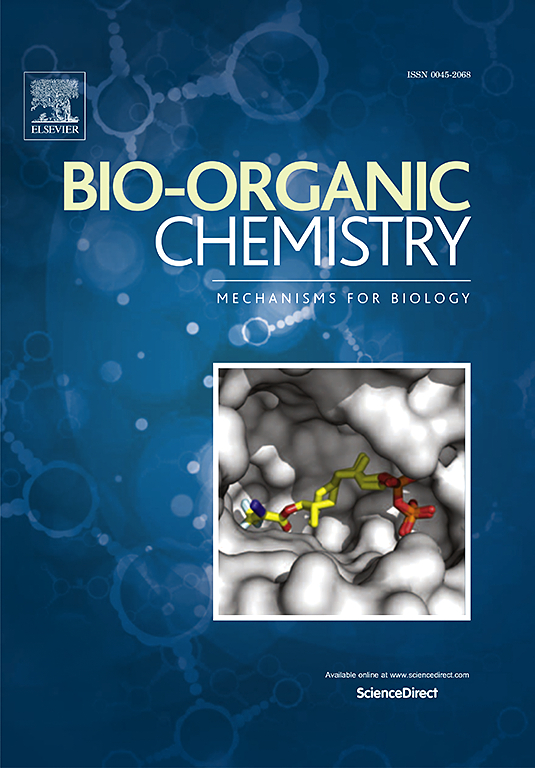阿利索B衍生物治疗非酒精性脂肪性肝炎的设计、合成及生物学评价
IF 4.5
2区 医学
Q1 BIOCHEMISTRY & MOLECULAR BIOLOGY
引用次数: 0
摘要
非酒精性脂肪性肝病(NAFLD),又称代谢功能障碍相关脂肪性肝病(MAFLD),是全球最常见的慢性肝病之一。NAFLD的特点是肝脏脂肪堆积,与过量饮酒无关。非酒精性脂肪性肝炎(NASH)是NAFLD的疾病进展,可发展为肝硬化和肝细胞癌。在以往的研究中,已经确定了艾利索B和艾利索b23 -醋酸酯对NASH和代谢综合征的临床前疗效。然而,关于阿利索尔B治疗NASH的专门结构优化的文献很少。本研究通过设计、合成和评价一系列芹素B衍生物(1-21),以提高芹素B的活性,获得治疗NASH的候选化合物。通过检测合成的化合物对新生脂肪生成和α-SMA基因表达的影响,初步探讨其构效关系(SAR)。选择化合物14和21进行进一步的体内研究。采用高脂饮食加四氯化碳(HFD + CCl4)诱导的NASH小鼠模型进行体内生物学评价。化合物14和21能有效改善HFD + CCl4小鼠肝脏脂肪变性、水肿、炎症浸润和肝纤维化。因此,14和21是治疗NASH的有希望的先导化合物。本文章由计算机程序翻译,如有差异,请以英文原文为准。

Design, synthesis and biological evaluation of Alisol B derivatives for potential treatment of non-alcoholic steatohepatitis
Non-alcoholic fatty liver disease (NAFLD), also known as metabolic dysfunction- associated with fatty liver disease (MAFLD), is one of the most prevalent chronic liver diseases globally. NAFLD is characterized by the accumulation of liver fat unrelated to excessive alcohol consumption. Non-alcoholic steatohepatitis (NASH) is the disease progression of NAFLD and could develop into cirrhosis and hepatocellular carcinoma. In previous studies, the preclinical efficacy of alisol B and alisol B 23-acetate against NASH and metabolic syndrome was identified. However, there is a paucity of literature pertaining to the specialized structural optimization of alisol B for the treatment of NASH. In this study, a series of alisol B derivatives (1–21) were designed, synthesized and evaluated in order to improve the activity of alisol B and to obtain candidate compounds for treating NASH. The effects of the synthesized compounds on de novo lipogenesis and α-SMA gene expression were tested to explore the preliminary structure–activity relationship (SAR). Compounds 14 and 21 were selected for further in vivo investigation. The high-fat diet plus carbon tetrachloride (HFD + CCl4)-induced NASH mice model was employed for biological evaluation in vivo. Compounds 14 and 21 effectively improved hepatic steatosis, ballooning, inflammatory infiltration, and hepatic fibrosis in the livers of HFD + CCl4 mice. Thus, 14 and 21 are promising lead compounds for the treatment of NASH.
求助全文
通过发布文献求助,成功后即可免费获取论文全文。
去求助
来源期刊

Bioorganic Chemistry
生物-生化与分子生物学
CiteScore
9.70
自引率
3.90%
发文量
679
审稿时长
31 days
期刊介绍:
Bioorganic Chemistry publishes research that addresses biological questions at the molecular level, using organic chemistry and principles of physical organic chemistry. The scope of the journal covers a range of topics at the organic chemistry-biology interface, including: enzyme catalysis, biotransformation and enzyme inhibition; nucleic acids chemistry; medicinal chemistry; natural product chemistry, natural product synthesis and natural product biosynthesis; antimicrobial agents; lipid and peptide chemistry; biophysical chemistry; biological probes; bio-orthogonal chemistry and biomimetic chemistry.
For manuscripts dealing with synthetic bioactive compounds, the Journal requires that the molecular target of the compounds described must be known, and must be demonstrated experimentally in the manuscript. For studies involving natural products, if the molecular target is unknown, some data beyond simple cell-based toxicity studies to provide insight into the mechanism of action is required. Studies supported by molecular docking are welcome, but must be supported by experimental data. The Journal does not consider manuscripts that are purely theoretical or computational in nature.
The Journal publishes regular articles, short communications and reviews. Reviews are normally invited by Editors or Editorial Board members. Authors of unsolicited reviews should first contact an Editor or Editorial Board member to determine whether the proposed article is within the scope of the Journal.
 求助内容:
求助内容: 应助结果提醒方式:
应助结果提醒方式:


